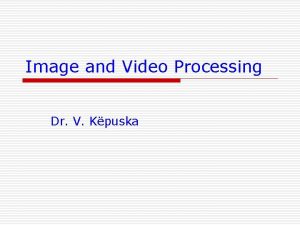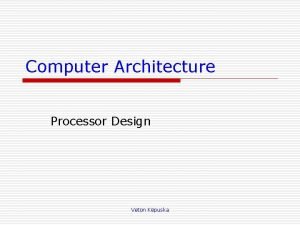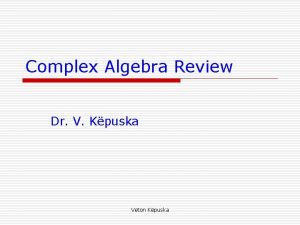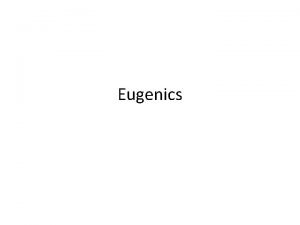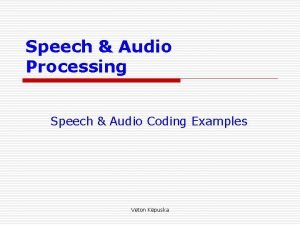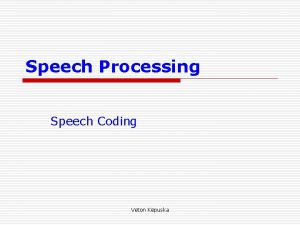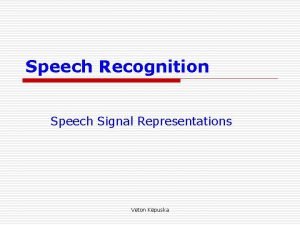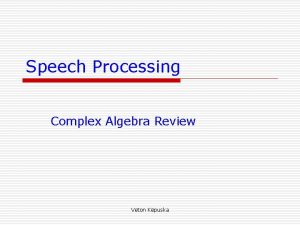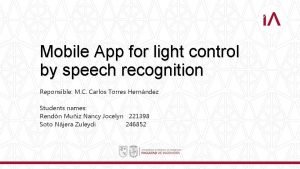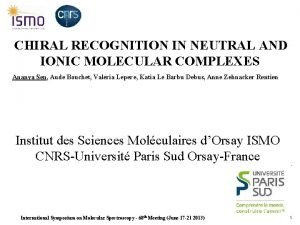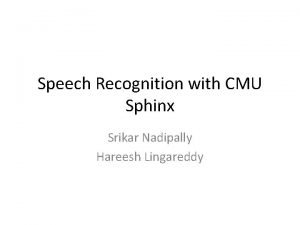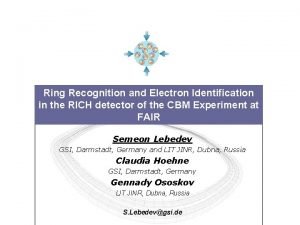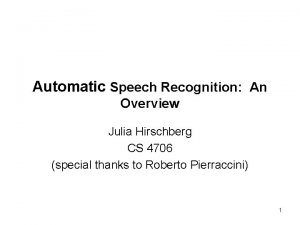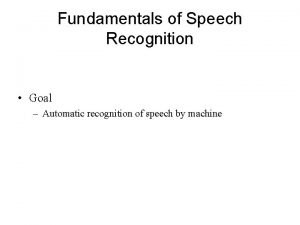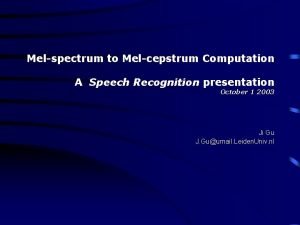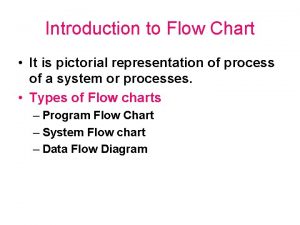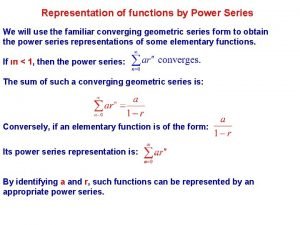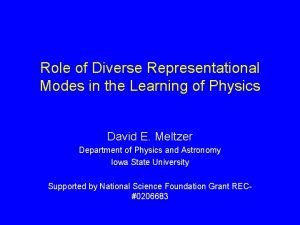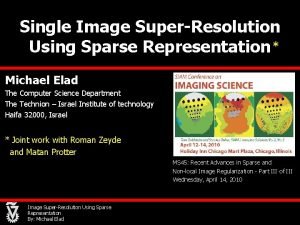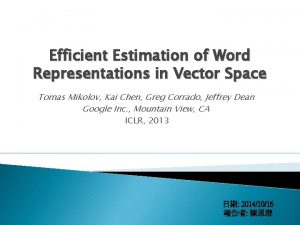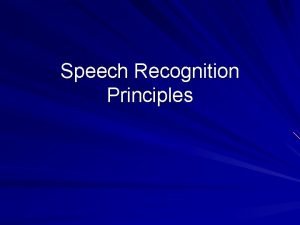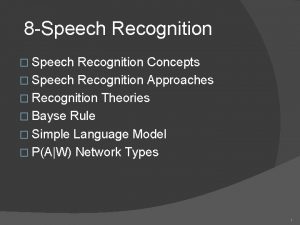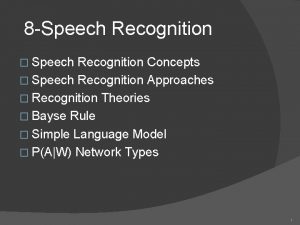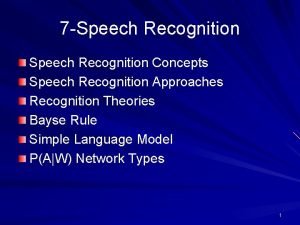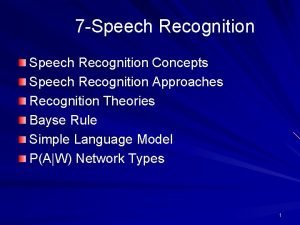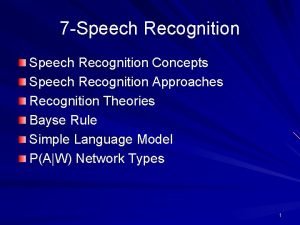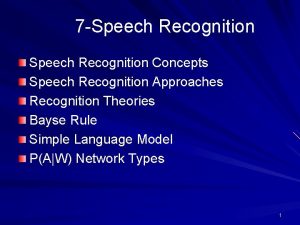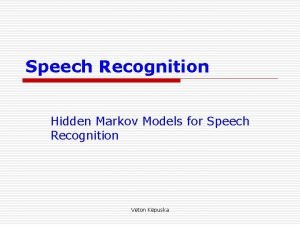Speech Recognition Speech Signal Representations Veton Kpuska Speech


![Discrete-Time Fourier Transform u Definition: u Sufficient condition for convergence: n 9/17/2020 Although x[n] Discrete-Time Fourier Transform u Definition: u Sufficient condition for convergence: n 9/17/2020 Although x[n]](https://slidetodoc.com/presentation_image/50843fc652ca10843fd2d1241d396fbe/image-3.jpg)











![Cepstral Analysis u Cepstral analysis for convolution is based on the observation that: x[n]= Cepstral Analysis u Cepstral analysis for convolution is based on the observation that: x[n]=](https://slidetodoc.com/presentation_image/50843fc652ca10843fd2d1241d396fbe/image-15.jpg)





![Cepstral Analysis of Speech u u u For voiced speech: For unvoiced speech: s[n]=w[n]*v[n]*r[n]= Cepstral Analysis of Speech u u u For voiced speech: For unvoiced speech: s[n]=w[n]*v[n]*r[n]=](https://slidetodoc.com/presentation_image/50843fc652ca10843fd2d1241d396fbe/image-21.jpg)














- Slides: 35

Speech Recognition Speech Signal Representations Veton Këpuska

Speech Signal Representations u Fourier Analysis n n n u Cepstral Analysis n n n u Discrete-time Fourier transform Short-time Fourier transform Discrete Fourier transform The complex cepstrum and the cepstrum Computational considerations Cepstral analysis of speech Applications to speech recognition Mel-Frequency cepstral representation Performance Comparison of Various Representations 9/17/2020 Veton Këpuska 2
![DiscreteTime Fourier Transform u Definition u Sufficient condition for convergence n 9172020 Although xn Discrete-Time Fourier Transform u Definition: u Sufficient condition for convergence: n 9/17/2020 Although x[n]](https://slidetodoc.com/presentation_image/50843fc652ca10843fd2d1241d396fbe/image-3.jpg)
Discrete-Time Fourier Transform u Definition: u Sufficient condition for convergence: n 9/17/2020 Although x[n] is discrete, X(ej ) is continuous and periodic with period 2ƒ. Veton Këpuska 3

Discrete-Time Fourier Transform n 9/17/2020 Convolution/multiplication duality: Veton Këpuska 4

Short-Time Fourier Analysis (Time-Dependent Fourier Transform) 9/17/2020 Veton Këpuska 5

Rectangular Window 9/17/2020 Veton Këpuska 6

Hamming Window 9/17/2020 Veton Këpuska 7

Comparison of Windows 9/17/2020 Veton Këpuska 8

Comparison of Windows (cont’d) 9/17/2020 Veton Këpuska 9

A Wideband Spectrogram 9/17/2020 Veton Këpuska 10

A Narrowband Spectrogram 9/17/2020 Veton Këpuska 11

Discrete Fourier Transform u In general, the number of input points, N, and the number of frequency samples, M, need not be the same. n n 9/17/2020 If M>N , we must zero-pad the signal If M<N , we must time-alias the signal Veton Këpuska 12

Examples of Various Spectral Representations 9/17/2020 Veton Këpuska 13

Cepstral Analysis of Speech u The speech signal is often assumed to be the output of an LTI system; i. e. , it is the convolution of the input and the impulse response. n n If we are interested in characterizing the signal in terms of the parameters of such a model, we must go through the process of de -convolution. Cepstral, analysis is a common procedure used for such deconvolution. 9/17/2020 Veton Këpuska 14
![Cepstral Analysis u Cepstral analysis for convolution is based on the observation that xn Cepstral Analysis u Cepstral analysis for convolution is based on the observation that: x[n]=](https://slidetodoc.com/presentation_image/50843fc652ca10843fd2d1241d396fbe/image-15.jpg)
Cepstral Analysis u Cepstral analysis for convolution is based on the observation that: x[n]= x 1[n] * x 2[n] ⇒ X (z)= X 1(z)X 2(z) By taking the complex logarithm of X(z), then log{X (z)} =log{X 1(z)} + log{X 2(z)} = u If the complex logarithm is unique, and if then is a valid z-transform, The two convolved signals will be additive in this new, cepstral domain. u u If we restrict ourselves to the unit circle, z = ej , then: It can be shown that one approach to dealing with the problem of uniqueness is to require that arg{X(ejω)} be a continuous, odd, periodic function of ω. 9/17/2020 Veton Këpuska 15

Cepstral Analysis (cont’d) u u u ^ To the extent that X(z)=log{X(z)} is valid, It can easily be shown that c[n] is the even part of ^ x[n]. ^ ^ If x[n] is real and causal then x[n], be recovered from c[n]. This is known as the Minimum Phase condition. 9/17/2020 Veton Këpuska 16

An Example 9/17/2020 Veton Këpuska 17

An Example (cont’d) 9/17/2020 Veton Këpuska 18

Computational Considerations u We now replace the Fourier transform expressions by the discrete Fourier transform expressions is a sampled version of u u . Therefore, Likewise, where 9/17/2020 Veton Këpuska 19

Computational Considerations (cont. ) u To minimize aliasing, N must be large 9/17/2020 Veton Këpuska 20
![Cepstral Analysis of Speech u u u For voiced speech For unvoiced speech snwnvnrn Cepstral Analysis of Speech u u u For voiced speech: For unvoiced speech: s[n]=w[n]*v[n]*r[n]=](https://slidetodoc.com/presentation_image/50843fc652ca10843fd2d1241d396fbe/image-21.jpg)
Cepstral Analysis of Speech u u u For voiced speech: For unvoiced speech: s[n]=w[n]*v[n]*r[n]= w[n]* hu[n]. Contributions to the cepstrum due to periodic excitation will occur at integer multiples of the fundamental period. Contributions due to the glottal waveform (for voiced speech), vocal tract, and radiation will be concentrated in the low quefrency region, and will decay rapidly with n. Deconvolution can be achieved by multiplying the cepstrum with an appropriate window, l[n]. 9/17/2020 Veton Këpuska 21

Cepstral Analysis of Speech Where D* is the characteristic system that converts convolution into addition. u Thus cepstral analysis can be used for pitch extraction and formant tracking. 9/17/2020 Veton Këpuska 22

Example of Cepstral Analysis of Vowel (Rectangular Window) 9/17/2020 Veton Këpuska 23

Example of Cepstral Analysis of Vowel (Tapering Window) 9/17/2020 Veton Këpuska 24

Example of Cepstral Analysis of Fricative (Rectangular Window) 9/17/2020 Veton Këpuska 25

Example of Cepstral Analysis of Fricative (Tapering Window) 9/17/2020 Veton Këpuska 26

The Use of Cepstrum for Speech Recognition u Many current speech recognition systems represent the speech signal as a set of cepstral coefficients, computed at a fixed frame rate. In addition, the time derivatives of the cepstral coefficients have also been used. 9/17/2020 Veton Këpuska 27

Cepstral Coefficients (Tohkura, 1987) u From a digit database (100 speakers) over dial-up telephone lines. 9/17/2020 Veton Këpuska 28

Mel-Frequency Cepstral Representation (Mermelstein & Davis 1980) u Some recognition systems use Mel-scale cepstral coefficients to mimic auditory processing. (Mel frequency scale is linear up to 100 Hz and logarithmic thereafter. ) This is done by multiplying the magnitude (or log magnitude) of S(ej ) with a set of filter weights as shown below: 9/17/2020 Veton Këpuska 29

Typical MFCC Based System u Front-End Processing of a Speech Recognizer 9/17/2020 Veton Këpuska 30

9/17/2020 Veton Këpuska 31

Signal Representation Comparisons u u Many researchers have compared cepstral representations with Fourier -, LPC-, and auditory-based representations. Cepstral representation typically out-performs Fourier-and LPC-based representations. Example: Classification of 16 vowels using ANN (Meng, 1991) 9/17/2020 Veton Këpuska 32

Signal Representation Comparisons (cont. ) u Performance of various signal representations cannot be compared without considering how the features will be used, i. e. , the pattern classiffication techniques used. (Leung, et al. , 1993). 9/17/2020 Veton Këpuska 33

Things to Ponder. . . u u u Are there other spectral representations that we should consider (e. g. , models of the human auditory system)? What about representing the speech signal in terms of phonetically motivated attributes (e. g. , formants, durations, fundamental frequency contours)? How do we make use of these (sometimes heterogeneous) features for recognition (i. e. , what are the appropriate methods for modeling them)? 9/17/2020 Veton Këpuska 34

References 1. 2. 3. 4. Tohkura, Y. , “A Weighted Cepstral Distance Measure for Speech Recognition, " IEEE Trans. ASSP, Vol. ASSP -35, No. 10, 1414 -1422, 1987. Mermelstein, P. and Davis, S. , “Comparison of Parametric Representations for Monosyllabic Word Recognition in Continuously Spoken Sentences, " IEEE Trans. ASSP, Vol. ASSP-28, No. 4, 357 -366, 1980. Meng, H. , The Use of Distinctive Features for Automatic Speech Recognition, SM Thesis, MIT EECS, 1991. Leung, H. , Chigier, B. , and Glass, J. , “A Comparative Study of Signal Represention and Classi. cation Techniques for Speech Recognition, " Proc. ICASSP, Vol. II, 680 -683, 1993. 9/17/2020 Veton Këpuska 35
 Veton kepuska
Veton kepuska Gaussia
Gaussia Kpuska
Kpuska Kpuska
Kpuska Hidden markov chain
Hidden markov chain Theresienstadt kinder
Theresienstadt kinder Veton kepuska
Veton kepuska Veton kepuska
Veton kepuska Veton kepuska
Veton kepuska Algebra
Algebra Baseband signal and bandpass signal
Baseband signal and bandpass signal Digital signal as a composite analog signal
Digital signal as a composite analog signal The product of two odd signals is
The product of two odd signals is Baseband signal and bandpass signal
Baseband signal and bandpass signal Speech recognition app inventor
Speech recognition app inventor Deep learning speech recognition
Deep learning speech recognition Speech recognition software
Speech recognition software Dragon speech recognition
Dragon speech recognition Ionic speech recognition
Ionic speech recognition Cmu speech recognition
Cmu speech recognition Electron speech recognition
Electron speech recognition Julia speech recognition
Julia speech recognition Speech recognition
Speech recognition Fundamentals of speech recognition
Fundamentals of speech recognition Kinect for windows speech recognition language pack
Kinect for windows speech recognition language pack Htk tutorial
Htk tutorial Melspectrum
Melspectrum Flowchart is a pictorial representation of
Flowchart is a pictorial representation of Cultural representations and signifying practices
Cultural representations and signifying practices Representations of functions as power series
Representations of functions as power series Multiple representations
Multiple representations What is a floor plan in maths
What is a floor plan in maths On single image scale-up using sparse-representations
On single image scale-up using sparse-representations Generalization pattern organizer
Generalization pattern organizer Economics
Economics Efficient estimation of word representations
Efficient estimation of word representations

